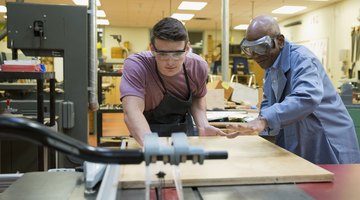The list of vocational programs may surprise you. Around 30 million good jobs exist that don’t require a four-year college degree, according to a 2019 Georgetown University Center on Education and the Workforce report. If you enjoy working with your hands and want to acquire marketable skills, your vocational career options are endless.
Tip
The vocational courses list includes programs that can be completed quickly. You can earn a certificate in just a few weeks. A technology diploma or an associate degree is typically completed in two years or less.
What’s a Trade School?
Trades schools in the United States were originally established to teach manual skills to young men with a mechanical aptitude. Over the years, all that changed. No longer are you limited to learning how to weld, fix motors or operate a boiler if you enroll in trade school.
Career-training programs are available in virtually all occupational fields. Moreover, new jobs are popping up all the time as technology changes the workplace. Trade schools, private career colleges, vocational institutes, community colleges and all branches of the armed services offer a wide range of vocational classes.
Depending on your interests, you can acquire the skills you need to work with people, plants, animals, data, machines, building materials, technology, computers and much more. Trade schools also teach students to communicate and work in teams. Faculty members have time to provide feedback and encouragement to each student.
What Are Vocational Classes Like?
Many people have vivid classroom memories of slouching down in a little desk hoping that the teacher doesn’t call on them. Vocational classes are different. Vocational school teachers provide some direction in the classroom, but most of the teaching and learning takes place in realistic work settings.
A typical day of vocational classes includes listening and watching closely as the instructor explains and demonstrates the use of materials, tools and techniques. Students then work individually or in small groups on related assignments. Students must also understand and follow expected safety protocols.
List of Vocational Skills
The list of vocational skills taught at trade schools and two-year colleges generally matches the needs of local employers. For instance, Minneapolis Community and Technical College offers aircraft maintenance technician training at the nearby Delta Air Lines facilities. Students acquire the knowledge and skills to inspect hydraulic systems, overhaul turbine engines, weld aircraft parts and fix landing gear.
Occupations in the workforce are clustered according to the skills needed to do the job. These career clusters can help you understand the level of training required for the jobs you are exploring. Within each occupational area, there are career pathways that start with on-the-job training, an apprenticeship or a trade school.
Agribusiness Vocational Training
Farming and business are closely related. Under the umbrella of agribusiness, students can enroll in vocational classes that deal with the management and production of plants, crops and livestock. For instance, Ohio State University’s Agricultural Technical Institute offers 26 associate degrees in many specializations.
Examples:
- Agronomy
- Agricultural communication
- Animal science
- Food science
- Horticulture
- Sustainable agriculture
Building and Construction
Technical schools across the country offer vocational classes that prepare students to work in the building trades industry. Students gain skills needed for designing floor plans, reading blueprints, using AutoCAD software, installing plumbing and erecting buildings. Jobs are available in all phases of construction.
Examples:
- Architectural computer technology
- Carpentry
- Heating and air conditioning
- Land surveying
- Plumbing and electricity
Business and Finance
The list of vocational programs within the field of business is impressive. Popular areas of emphasis include marketing, advertising, public relations, management, human resources, administrative support and accounting, for instance. A business credential is versatile and helps you get your foot in the door.
Examples:
- Bank teller or loan officer
- Business manager
- Hotel and resort manager
- Professional sales
- Insurance sales
- Marketing research
- SEO analyst
- Retail merchandiser
Computer and Information Technology
One of the fastest ways to escape a dead-end job is to learn computer skills. A wide range of vocational classes are available to help students master technology. If you like problem solving and figuring out how things work, you may enjoy working with computers, robotics and artificial intelligence.
Examples:
- Cloud computing
- Computer programming
- Cybersecurity
- Network support
- PC repair
- Video game designer
- Web designer
Health Science
Excellent salaries and benefits come with many careers in the medical profession. Although the work can be demanding and stressful, helping patients brings gratifying rewards. High school classes in math and science provide a solid foundation for difficult vocational and community college classes such as anatomy, chemistry and algebra.
Examples:
- Nursing
- Occupational therapy assistant
- Paramedic
- Dental hygienist
- Dialysis technician
- Medical assistant
- Medical technologist
- Phlebotomist
- Surgical technologist
Personal Services
If you value health, wellness and beauty, you may want to consider a career that helps people look and feel their best. Vocational classes in personal services involve learning by studying, observing and doing. After completing practical studies and graduating, you will be able to sit for the state licensing examination for your profession.
Examples:
- Cosmetologist
- Fitness instructor
- Massage therapist
- Nail technician
- Personal trainer
- Skin care specialist
Manufacturing, Transportation and Logistics
Manufacturing relies heavily on efficient transportation and movement of goods. Skilled workers are needed to manage logistical operations based on supply and demand. Important decisions must be made about shipping, warehouse storage and inventory control. Vocational classes in transportation services, warehouse operations, quality assurance and environmental safety prepare students to jump right into a job.
Examples:
- Inventory control
- Quality control
- Supply-chain manager
- Professional truck driver
- Forklift operator
- Warehouse and distribution
- Health and environmental safety
What Is a Trade School?
A trade school is an educational institution that teaches students marketable skills sought by employers. Some trade schools focus on preparing students for related occupations. For instance, Liv Aveda Institutes offers vocational training through their cosmetology school, esthetician school and massage therapy school. Other trade schools offer many different and unrelated vocational training programs.
Career colleges, vocational institutes and community colleges offering applied associate degrees can be considered a type of trade school. Classes are generally small enough to ensure that each student receives individualized attention and proper supervision. Graduates of accredited vocational training programs may sit for state or local licensing exams.
Consider an Apprenticeship
An apprenticeship combines supervised on-the-job training with vocational courses. Employers, professional trade organizations and labor unions offer apprenticeships to increase the number of skilled workers available to fill high-demand jobs. Tuition is covered, and apprentices receive a salary. According to the U.S. Department of Labor, the Registered Apprenticeship program includes 1,000 occupations.
Examples:
- Pipefitting
- Carpentry
- Law enforcement
- Child development
- Culinary arts
- Dental assisting
- Construction
- Electrical wiring
Explore Certificate Programs
A certificate is awarded upon completion of a short vocational course that takes anywhere from a few weeks to about 18 months. Students are taught basic concepts, which they put into practice under a qualified supervisor. Certificates can help individuals get back into the workforce, change jobs or upgrade their skills for a promotion.
For instance, South Central College offers a 23-credit payroll certificate that prepares students for entry-level jobs in payroll accounting. The school also offers a broader 34-credit accounting assistant diploma and a 71-credit A.A.S. degree in accounting. Credits earned in the certificate and diploma program can be applied toward an A.A.S. degree.
Examples:
- Accounting clerk
- American Sign Language interpreter
- Digital media
- Floral arranging
- Heating, ventilation and air conditioning (HVAC)
- Web design
- Welding
- ServSafe food safety
Look Into a Vocational Diploma
A vocational diploma is more comprehensive than a certificate. Diplomas appeal to individuals already working in the field as well as certificate holders seeking advanced training. After earning a certificate and a diploma, some students pursue an Associate of Applied Science degree.
Learn About Occupational Diplomas
An occupational diploma for individuals with mild to moderate disabilities is available at some two-year public schools. For example, Central Lakes College awards a nine-month occupational diploma that prepares students with disabilities to compete for entry-level jobs. The program helps students acquire employability skills in a community work site. Participants gain self-confidence, learn computer basics and master independent living skills.
Seek an Associate of Applied Science Degree
An Associate of Applied Science degree is a two-year college degree with a technical emphasis that prepares students to succeed in their chosen career field. A few liberal arts classes are required in addition to a vocational courses list that must be completed. Depending on the program, some or all vocational classes may count toward a four-year degree. Most student with an A.A.S. degree directly enter the workforce.
Examples:
- Auto body repair
- Biotechnology
- Construction management technology
- Child development
- Computer information systems
- Criminal justice – law enforcement
- Fashion marketing
- Human services – addiction counseling
- Radio-TV-film production
- Veterinary technology
Seek Vocational Training in the Military
After finishing basic training, soldiers attend occupation-specific vocational classes. Assignment to vocational programs is based on the results of aptitude testing. Soldiers train in areas such as aviation, logistical operations, communication systems, leadership, law enforcement, cybersecurity, computer technology and business administration.
The military partners with the American Council on Education to deliver training that veterans can use in civilian life. Military training counts toward a degree at many postsecondary institutions. Members of the armed services also receive educational benefits.
Advantages of Vocational Training
According to the Georgetown University Center on Education and the Workforce, skilled workers with career certificates, diplomas and associate degrees hold 24 percent of all good jobs in the United States. Georgetown University defines a good job as one that pays at least $45,000 per year for workers between the ages of 45-64 or a minimum of $35,000 for workers age 25 to 44. Moreover, 30 million good jobs do not require a bachelor’s degree.
Postsecondary training correlates with lower unemployment because trade school graduates have marketable skills. Apprentices and vocational school graduates are generally more likely than college graduates to finish their studies with little to no student loan debt. Many occupations such as nursing are needed across the country, making it easier to relocate if workers or family members desire to move.
The list of vocational programs includes career pathways to high-paying occupations. Trade schools that receive government support must disclose information about graduation rates, job placement and average salaries. It is important to have realistic salary expectations when starting a training program.
Good Jobs and Good Salaries
The Bureau of Labor Statistics provides salary data on occupations in the U.S. Specifically, the BLS keeps track of the median salaries of jobs that make up the workforce. Median salary means that half of all workers on the wage continuum earn less than the midpoint, and half earn more.
2017 Median Salaries:
- Air traffic controller: $75,000 or more
- Cardiovascular technician: $55,000 to $74,999
- Computer network support specialist: $55,000 to $74,999
- Court reporter: $55,000 to $74,999
- Electrical engineering technician: $55,000 to $74,999
- Magnetic resonance imaging technologist: $55,000 to $74,999
- Mechanical drafter: $55,000 to $74,999
- Nuclear technologist: $75,000 or more
- Occupational therapy assistant: $55,000 to $74,999
- Radiation therapist: $75,000 or more
- Web developer: $55,000 to $74,999
Related Articles
References
- Minneapolis College Catalog: Aircraft Maintenance Technician
- St. Cloud Technical & Community College: Degrees & Programs
- Advance CTE: State Leaders Connecting Learning to Work: Career Clusters
- Austin Community College: Academic & Career Programs
- Central Lakes College: Occupational Skills Diploma
- Time: How Community Colleges Changed the Whole Idea of Education in America
- Georgetown University Center on Education and the Workforce: Three Educational Pathways to Good Jobs
- Bureau of Labor Statistics: Occupation Finder
Writer Bio
Dr. Mary Dowd is a dean of students whose job includes student conduct, leading the behavioral consultation team, crisis response, retention and the working with the veterans resource center. She enjoys helping parents and students solve problems through advising, teaching and writing online articles that appear on many sites. Dr. Dowd also contributes to scholarly books and journal articles.










